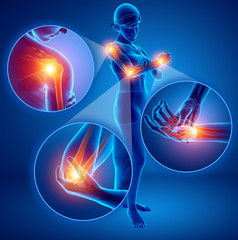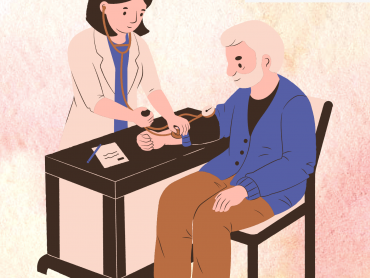Lifestyle plays a major role in our health. In our progressive, learning & growing lifestyles today, there is a clear lack of a healthy diet, good quality sleep, and physical activity, while there is the presence of habits such as drinking and smoking. All this has its effects and repercussions on our health. One of the major side effects of a sedentary lifestyle we see today is rheumatic diseases.
Rheumatic diseases are those conditions that cause damage to an individual’s musculoskeletal system. They usually manifest as pain and fatigue and so severely impact the quality of life. They are primarily classified into inflammatory & non-inflammatory types and they usually develop gradually, leading to incremental limitations in movements and activities of the affected individual.
Rheumatic or musculoskeletal disorders are quite prevalent and are seen to affect people all across the globe. Women are likely to suffer more commonly from these diseases than males. Studies show that in the UK, people quit work within 5 years from the diagnosis of the disease & there has been an increase of almost 40% in co-existing conditions like cardiovascular diseases, respiratory diseases & depression due to the pain and inflammation associated with musculoskeletal disorders.

When we talk about rheumatic diseases and lifestyle, the various signs and symptoms need to be mentioned. One of the most common symptoms of rheumatic diseases is joint pain, especially of the knee joint, which is usually affected in all age groups. While it is common in the older age group, knee pain in young patients is primarily due to obesity. India has the 2nd highest number of obese children in the world and this obesity in children leads to rheumatic diseases.
A classic sign of rheumatic diseases is that joint pain is typically seen in early in the morning. Also, the pain is not severe in the initial stages of the disease but goes on to increase as the disease progresses. This pain associated with the disease may cause swelling, which is mostly seen in the wrist and the ankle joint. In severe cases, pain attacks can occur at any time of the day. In such cases, the skin on the joint is often red & hot due to the inflammation of synovial tissues.
So far we have been referring to rheumatic diseases as a collection or group of diseases. But, it is imperative to mention that rheumatic diseases are of various types –
- Rheumatoid Arthritis- Commonly affects joints of the wrist, elbow, knee & ankles.
- Osteoarthritis- Can affect any of the joints in the body but it mainly it affects the knees and feet.
- Gout- Uric acid crystals in the blood that gets deposited in the joints, primarily the ankle joint.
- Systemic Lupus Erythematosus- Is an inflammatory condition wherein the immune system attacks its own tissues and affects the kidneys, skin, lungs, and joints
- Fibromyalgia- Is a chronic inflammatory condition of the musculoskeletal system and causes fatigue, pain and mental distress.
- Infectious arthritis or septic arthritis- Is a type of arthritis that is caused by Staphylococcus aureus bacteria which enter the body via the urinary tract or the intestines.
- Psoriatic Arthritis- This type of arthritis affects individuals with psoriasis and there is no permanent cure for this condition.
- Ankylosing Spondylitis- Is a chronic condition, like most other types of arthritis and usually affects the base of the spine and pelvic bones.
That brings us to a pressing question – How to prevent rheumatic diseases in all age groups in the current lifestyles of people?
 Well, firstly, let’s get this clear– Rheumatic diseases are preventable. They are mainly activated by factors like sedentary lifestyle, environmental factors, and genetics. The food we eat is an important key to prevention of rheumatic diseases. Though there is no ideal diet to prevent rheumatic diseases, certain foods help reduce inflammation and pain by improving immune response. Consuming foods rich in omega 3 fatty acid helps in reducing inflammation in the body. Some foods rich in it are soya, fish and nuts. Nuts are also a rich source of protein & fibres).
Well, firstly, let’s get this clear– Rheumatic diseases are preventable. They are mainly activated by factors like sedentary lifestyle, environmental factors, and genetics. The food we eat is an important key to prevention of rheumatic diseases. Though there is no ideal diet to prevent rheumatic diseases, certain foods help reduce inflammation and pain by improving immune response. Consuming foods rich in omega 3 fatty acid helps in reducing inflammation in the body. Some foods rich in it are soya, fish and nuts. Nuts are also a rich source of protein & fibres).
Apart from this, foods rich in iron(leafy greens like spinach, broccoli), vitamins A, C (some leafy greens, fruits like strawberries, lemon, oranges etc, and D (milk, eggs, dairy products), and antioxidants (coloured fruits, green tea etc.,) have shown to benefit those individuals living with rheumatic diseases. Vitamins A and C function as antioxidants and prevent free radical damage and inflammation in the body whereas, vitamin D and calcium are needed for the proper functioning of the bones and muscles.
 Apart from the diet, another important measure to prevent rheumatic diseases at all ages is to break the sedentary lifestyle and getting fit! One can begin with simple exercises that can enhance bone and muscle strength, and promote joint movements. Exercises such as yoga, swimming, walking, biking, and stretching are easy to do and can be done in as little as a minimum of half an hour. However, one must avoid exercises during joint pain or tenderness of joints. Children who suffer from juvenile arthritis should be motivated to participate in outdoor activities like cycling, running etc., to train their bones and muscles for activity. Exercises are highly beneficial for pain relief in rheumatic diseases and warm-ups before any exercise can help reduce stiffness in the joints and increases movements of joints required to perform the regular exercises. Being active also improves mood and bring about an improvement in the quality of life of those living with rheumatic diseases.
Apart from the diet, another important measure to prevent rheumatic diseases at all ages is to break the sedentary lifestyle and getting fit! One can begin with simple exercises that can enhance bone and muscle strength, and promote joint movements. Exercises such as yoga, swimming, walking, biking, and stretching are easy to do and can be done in as little as a minimum of half an hour. However, one must avoid exercises during joint pain or tenderness of joints. Children who suffer from juvenile arthritis should be motivated to participate in outdoor activities like cycling, running etc., to train their bones and muscles for activity. Exercises are highly beneficial for pain relief in rheumatic diseases and warm-ups before any exercise can help reduce stiffness in the joints and increases movements of joints required to perform the regular exercises. Being active also improves mood and bring about an improvement in the quality of life of those living with rheumatic diseases.









